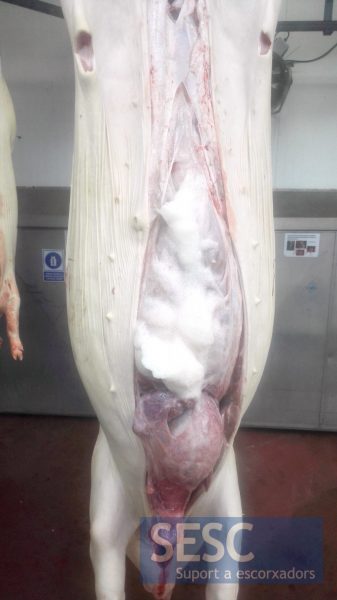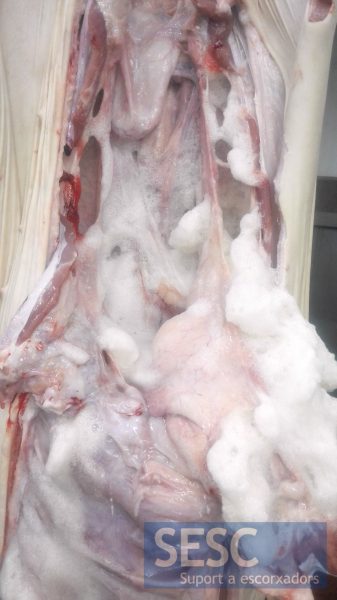The case of the pig with its belly full of foam
In a male, hybrid breed, 6 months old, pig carcass, upon opening the abdominal cavity, a large amount of serosanguinolent exudate with fibrin remains and an abundant amount of white foam was observed. The viscera had adherences between them and to the walls.
These lesions, and this was confirmed by histology, are compatible with fibrinopurulent peritonitis and ascites. The cause of these findings is usually of infectious origin. Among the bacteria that most commonly cause this lesion, we find Haemophilus parasuis, Streptococcus suis, Mycoplasma hyorrhinis, and more rarely Escherichia coli. However, it is not usual for these agents to cause lesions in animals of a slaughter age but rather in younger animals. Unfortunately the microbiological culture did not give a conclusive result, probably due to the chronicity of the process the causing bacterium was no longer present in the lesion.
What is unclear is the origin of the foam observed in this case. The foam is, ultimately, like an emulsion in which the dispersed phase is a gas. When a liquid is rich in protein (such as ascitic fluid, for example, that has abundant plasma proteins) or contains detergents it is easy for it to generate foam, but it remains to be explained how the air is incorporated into the abdominal cavity . Here we can elaborate on different hypotheses:
- It may be due to post-mortem changes. A small unnoticed cut at the beginning of the chain might have caused air to enter through the wall of the abdominal cavity that allowed the formation of foam (thanks to the presence of the ascites fluid).
- Another possibility, intra-vitam this time, is that the peritonitis coincides with an intestinal emphysema (Pneumatosis cystoides intestinalis). It is a lesion with no pathological significance and also of uncertain origin where the presence of air bubbles in the intestinal serous membrane is observed.
- Another possible origin of the gas would be bacterial fermentation.

When the carcass was cut open, the abdominal cavity was found filled up with serosanguinolent exudate and white foam.

Detail of the abdominal cavity appearance.

